Traditional food
Traditional food refers to foods and dishes that are passed through generations[1] and also refers to foods consumed over the long-term duration of civilization that have been passed through generations.[2] Traditional foods and dishes are traditional in nature, and may have a historic precedent in a national dish, regional cuisine[1] or local cuisine. Traditional foods and beverages may be produced as homemade, by restaurants and small manufacturers, and by large food processing plant facilities.[3]
Some traditional foods have geographical indications and traditional specialities in the European Union designations per European Union schemes of geographical indications and traditional specialties: Protected designation of origin (PDO), Protected geographical indication (PDI) and Traditional specialities guaranteed (TSG). These standards serve to promote and protect names of quality agricultural products and foodstuffs.[4]
This article also includes information about traditional beverages.
By continent
Africa
- Bambara groundnut – a traditional food crop in Africa
Europe
Traditional food products have been described as playing "an important part of European culture, identity, and heritage".[5]
South America
- Humita – a traditional food in Argentina, Bolivia, Chile, Ecuador and Peru
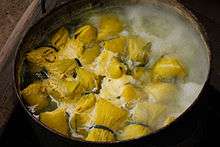 Wrapped humitas being cooked
Wrapped humitas being cooked
By country
Canada
- Country food refers to the traditional diets of Aboriginal people (known in Canada as First Nations, Metis, and Inuit), especially in remote northern regions where Western food is an expensive import, and traditional foods are still relied upon.[6][7]
- Thanksgiving dinner
- Tourtière
Acadia
China
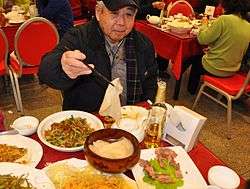
- Ciba cake
- Fuling jiabing – a traditional snack food of Beijing and is an integral part of the city's culture. It is a pancake-like snack made from flour, sugar, and fuling (Poria), rolled around nuts, honey, and other ingredients.
- Spring pancake – a traditional Chinese food unique to the northern regions. People eat spring pancakes on the day called lichun to celebrate the beginning of spring.
Costa Rica
Croatia
Cyprus
- Tsamarella – a traditional food and one of Cyprus' main lunch meats[10][11]
Czech Republic
England
Faroe Islands
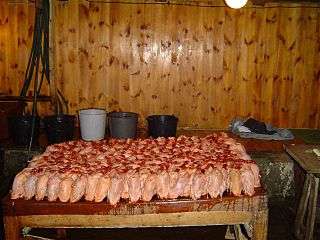
France
- Appellation d'origine contrôlée – the French certification granted to certain French geographical indications for wines, cheeses, butters, and other agricultural products
- Bresse chicken – a French chicken product with appellation d'origine contrôlée status
- List of Appellation d'Origine Contrôlée liqueurs and spirits
- List of Appellation d'Origine Contrôlée wines
Germany
- Black Forest ham – produced in the Black Forest region of Germany, it is a Protected Designation of Origin (PDO) food in the European Union.
Guatemala
- Fiambre is a traditional Guatemalan dish that is prepared and eaten yearly to celebrate the Day of the Dead (Día de los Muertos) and the All Saints Day (Día de Todos los Santos).
Iceland
- Hákarl – a traditional food[14] and national dish of Iceland
- Hangikjöt [15]
- Þorramatur – a selection of traditional Icelandic food,[16] consisting mainly of meat and fish products cured in a traditional manner, cut into slices or pieces and served with rúgbrauð (dense and dark rye bread), butter and brennivín (an Icelandic akvavit)
India
Indonesia

- Brem – a fermented snack and beverage from Java and Bali
- Docang – a traditional food from Cirebon
- Ketupat – a traditional rice dumpling commonly served during Lebaran, Indonesian Eid ul Fitr
- Pallubasa – a traditional food from Makassar, South Sulawesi made from offal of cattle or buffalo
- Pekalongan Regency § Traditional foods
- Rendang – traditional Minangkabau dish from West Sumatra
- Swikee – sometimes identified as a traditional food of Purwodadi, a city in Central Java[17]
- Tumpeng – An Indonesian national dish
Iran
Ireland
Italy
- Prosciutto (PDO)
- Ravioli
- Salami
By designation of origin
- Denominazione di origine controllata – a quality assurance label for Italian food products, especially Italian wine and cheese
- Indicazione geografica tipica
- Prodotto agroalimentare tradizionale is an official approval for traditional Italian regional food products similar to the Protected Geographical Status of the European Union.
- Strada dell'Olio – a kind of gastronomical route in Italy that crosses a territory rich of traditional products, PDOs and PGIs, DOCs and DOCGs in Italy.
Piedmont
- Panna cotta – The northern Italian Region of Piedmont includes panna cotta in its 2001 list of traditional food products of the region.[19] Panna cotta is not mentioned in Italian cookbooks before the 1960s,[20][21] yet it is often cited as a traditional dessert in Piedmont.
Japan
- Mochi – eaten year-round in Japan, mochi is a traditional food for the Japanese New Year and is commonly sold and eaten during that time
Jordan
Traditional beverages in Jordan include sous (also referred to as 'irqsus), a drink prepared using the dried root of Glycyrrhiza glabra (liquorice), tamr hindi, a drink prepared from an infusion of the dried pulp of Tamarindus indica (tamarind), and laban (labneh), a drink prepared with yogurt and water.[3] A significant amount of labneh in Jordan and nearby countries continues to be prepared using the traditional method of "straining set yogurt in cloth bags".[3]
Korea
Maldives
- Garudiya [lower-alpha 4]
- Maldive fish – cured tuna fish traditionally produced in the Maldives. It is a staple food in Maldivian cuisine
Malta
Mexico
- Atole [23]
- Capirotada – usually eaten during the Lenten period (comida de cuaresma).[24] It is one of the dishes served on Good Friday.
- Chiles [23]
- Enchilada [25]
- Iguana meat
- Legumes, beans and refried beans[23]
- Maize [26]
- Mole sauce [23]
- Pork [23]
- Rice – traditionally pan fried to a golden color before cooking [23]
- Rice and beans [28]
- Sope [29]
- Tamale [23]
Nepal
Portugal
- Denominação de Origem Controlada is the system of protected designation of origin for wines, cheeses, butters, and other agricultural products from Portugal.
Saudi Arabia
Scotland
Singapore
- Hainanese chicken rice – considered as a national dish of Singapore
- Teochew porridge
Slovakia
- Bryndzové halušky – a national dish of Slovakia consisting of halušky and bryndza.
- Lecsó
Spain
- Boroña – a cornbread that is a traditional food in the regions of Galicia, Asturias, Cantabria, the Basque Country and northern Castilla-Leon (areas of León, Palencia and Burgos)
- Denominación de Origen – part of a regulatory classification system primarily for Spanish wines (similar to the French appellations) but also for other foodstuffs like cheeses, condiments, honey and meats, among others
Swaziland
Switzerland
- Appellation d'origine protégée – A Swiss geographical indication protecting the origin and the quality of traditional food products other than wines
- Capuns – a traditional food from the canton of Graubünden in Switzerland
Tanzania
Thailand
Uganda
- Malewa – smoked bamboo shoot which is dried for preservation. The food originated from Eastern Uganda in the Bugisu sub-region
United Kingdom
United States
- Cardamom bread – considered as a traditional food among Swedish Americans
- Thanksgiving dinner
Southern United States
Vanuatu
- Lap lap – a national dish
Yemen
By region
Arab states of the Persian Gulf
- Khabees – traditional sweet dish in the Arab states of the Persian Gulf
Commonwealth Caribbean
- Rice and peas – a traditional dish in the Anglo-Caribbean
Eastern Mediterranean
Traditional foods of the Eastern Mediterranean region include falafel, fuul, halawa, hummus, kanafeh, labaneh, medammis and tahini.[3] among others. The most popular traditional foods in the region are those prepared from legumes, specifically, falafel, fuul, hummus and medammis.[3]
- Popular traditional foods in the Eastern Mediterranean region
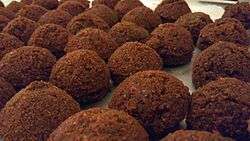

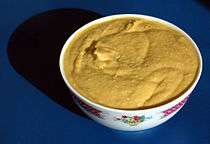

.jpg)
European Union
- Geographical indications and traditional specialities in the European Union
- Quality Wines Produced in Specified Regions – a quality indicator used within European Union wine regulations that identifies wines with protected geographical indications
- List of geographical designations for spirit drinks in the European Union
Scandinavia
Southern Africa
- Soured milk – a traditional food of the Bantu peoples of Southern Africa
See also
- Christmas dinner
- Appellation
- Shrove Tuesday – known in some countries as Pancake Tuesday or Pancake day
- Whole food
Notes
- ↑ "England's best-known traditional dish is fish and chips ..."[12]
- ↑ "... the Sunday roast; the tradition is continued every Sunday lunchtime in pubs and restaurants across England."[13]
- ↑ "... the sizzle of the traditional Sunday roast."[18]
- ↑ "Food in the Maldives may be thought of in three categories: the traditional fare, Sri Lanka cuisine and the newer imported foods. The traditional fare is mostly fish boiled in a broth called garudiya, and coconut pieces ..."[22]
References
- 1 2 Kristbergsson, K.; Oliveira, J. (2016). Traditional Foods: General and Consumer Aspects. Integrating Food Science and Engineering Knowledge Into the Food Chain. Springer US. pp. 85–86. ISBN 978-1-4899-7648-2.
- ↑ Saunders, Raine (October 28, 2010). "What Are Traditional Foods?". Agriculture Society. Retrieved 8 April 2015.
- 1 2 3 4 5 Who Regional Office for the Eastern Mediterranean (2010). Hazard Analysis and Critical Control Point Generic Models for Some Traditional Foods: A Manual for the Eastern Mediterranean Region. World Health Organization. pp. 41–50. ISBN 978-92-9021-590-5.
- ↑ "Geographical indications and traditional specialities". europa.eu.
- ↑ Guerrero, L.; (et al.) (November 1, 2010). "Consumer-driven definition of traditional food products and innovation in traditional foods. A qualitative cross-cultural study". Appetite. Retrieved April 8, 2015.
- ↑ Usher, Peter J. Evaluating Country Food in the Northern Native Economy (PDF). pp. 105–120.
- ↑ Wein, Eleanor E.; et al. (1990). "Food Consumption Patterns and Use of Country Foods by Native Canadians near Wood Buffalo National Park, Canada". Arctic. 44 (3): 196–206. doi:10.14430/arctic1539.
- ↑ Publishing, DK (2014). DK Eyewitness Travel Guide: Canada. Eyewitness Travel Guides. DK Publishing. p. 32. ISBN 978-1-4654-2221-7.
- ↑ Long, L.M. (2015). Ethnic American Food Today: A Cultural Encyclopedia. Ethnic American Food Today. Rowman & Littlefield Publishers. p. 135. ISBN 978-1-4422-2731-6.
- ↑ "Products and Recipes". visitcyprus.com. Cyprus Tourism Organisation. Retrieved 26 November 2015.
- ↑ "Σφαγή χοίρου & Παρασκευή παραδοσιακών αλλαντικών". foodmuseum.cs.ucy.ac.cy. Cyprus Food Virtual Museum. Retrieved 26 November 2015.
- ↑ Andrews, R. (2011). The Rough Guide to England. Rough Guides. p. 62. ISBN 978-1-4053-8845-0.
- ↑ Holland, E. (2012). Pocket Guide to Edwardian England. Createspace Independent Pub. p. pt12. ISBN 978-1-4781-1344-7.
- ↑ Helfman, G.; Burgess, G.H. (2014). Sharks. Sharks. Johns Hopkins University Press. p. 183. ISBN 978-1-4214-1310-5.
- ↑ Albala, K. (2011). Food Cultures of the World Encyclopedia [4 volumes]: [Four Volumes]. ABC-CLIO. p. 195. ISBN 978-0-313-37627-6.
- ↑ Kalland, A. (2009). Unveiling the Whale: Discourses on Whales and Whaling. Environmental Anthropology and Ethnobiology. Berghahn Books. p. 166. ISBN 978-1-84545-955-0.
- ↑ Harum Gurih si Swike Purwodadi
- ↑ Davenport, F. (2010). Dublin. City Travel Guide Series. Lonely Planet. p. 151. ISBN 978-1-74179-220-1.
- ↑ Riccardo Brocardo, "I prodotti agroalimentari tradizionali del Piemonte a quota 370", full text
- ↑ Camilla V. Saulsbury, Panna Cotta: Italy's Elegant Custard Made Easy, p. 14
- ↑ Luigi Carnacina, Luigi Veronelli, "Panna Cotta", La Cucina Rustica Regionale 1:156, 1977, based on La Buona Vera Cucina Italiana (not seen), 1966
- ↑ Maloney, Clarence (1980). "Garudiya",+traditional+food "People of the Maldive Islands". Orient Longman. Retrieved 27 March 2016.
- 1 2 3 4 5 6 7 8 Edelstein, S. (2009). Food, Cuisine, and Cultural Competency for Culinary, Hospitality, and Nutrition Professionals. Jones & Bartlett Learning. pp. 66–73. ISBN 978-0-7637-5965-0.
- ↑ Capirotada The Zenchilada page 102 Winter 2011]
- ↑ Tatum, C.M. (2013). Encyclopedia of Latino Culture: From Calaveras to Quinceaneras [3 Volumes]: From Calaveras to Quinceañeras. Cultures of the American Mosaic. ABC-CLIO. p. 466. ISBN 978-1-4408-0099-3. Retrieved March 27, 2016.
- ↑ Schanbacher, W.D. (2010). The Politics of Food: The Global Conflict Between Food Security and Food Sovereignty. Praeger Security International Series. Praeger Security International. p. 42. ISBN 978-0-313-36328-3.
- ↑ Sparks, P.; Swanson, B. (1993). Tortillas!: 75 Quick and Easy Ways to Turn Simple Tortillas Into Healthy Snacks and Mealtime Feasts. St. Martin's Press. p. 3. ISBN 978-0-312-08912-2.
- ↑ Adapon, J. (2008). Culinary Art and Anthropology. Bloomsbury Publishing. p. 15. ISBN 978-1-84788-455-8.
- ↑ Herbst, R.; Herbst, S.T. (2015). The Deluxe Food Lover's Companion, 2nd edition. Barron's Educational Series. p. pt901. ISBN 978-1-4380-7621-8.
- ↑ Dieterle, H.; Friedman, A. (2014). Harold Dieterle's Kitchen Notebook. Grand Central Publishing. p. pt45. ISBN 978-1-4555-2864-6.
- ↑ Greenberg, P. (2012). The Best Places for Everything: The Ultimate Insider's Guide to the Greatest Experiences Around the World. Rodale Books. p. 271. ISBN 978-1-60961-829-2.
- ↑ Gabriel, J. (2014). How to Cook Like a Southerner: Classic Recipes from the South's Best Down-Home Cooks. Thomas Nelson. p. 31. ISBN 978-1-4016-0506-3.
- 1 2 3 4 "Try traditional Southern foods for New Year's". Bradenton Herald. December 31, 2008. Retrieved March 27, 2016.
Further reading
- Ferrando, R. (1981). Traditional and Non-traditional Foods. FAO food and nutrition series. Food and Agriculture Organization of the United Nations. ISBN 978-92-5-100167-7.
- Yanagida, F.; Kenkyūjo, Tōkyō Nōgyō Daigaku. Sōgō (1987). Traditional foods and their processing in Asia. NODAI Research Institue, Tokyo University of Agriculture.
- Zaigui, L.; Hongzhuo, T. (2009). Traditional Chinese Foods: Production and Research Progress. Food science and technology series. Nova Science Publishers. ISBN 978-1-60692-902-5.
- Ray, R.C.; Didier, M. (2014). Microorganisms and Fermentation of Traditional Foods. Food Biology Series. Taylor & Francis. ISBN 978-1-4822-2308-8.
